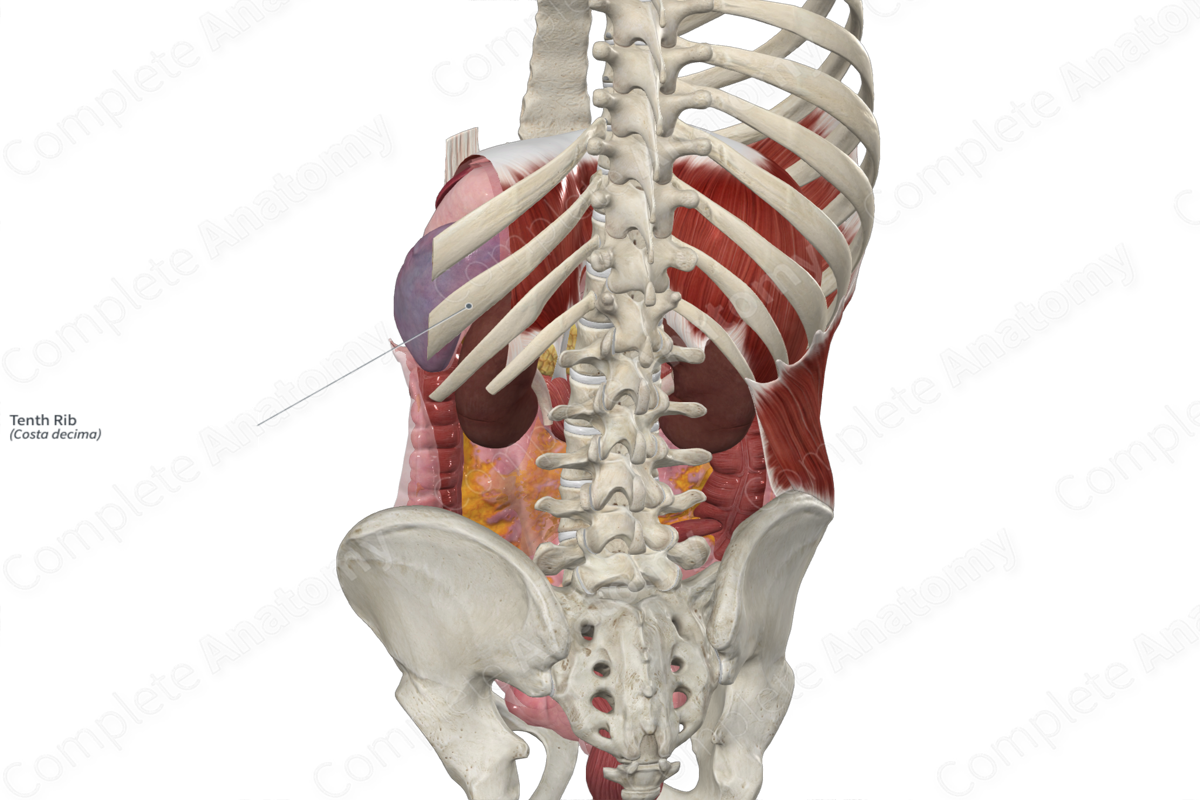
Quick Facts
Location: Thoracic cage.
Bone Type: Flat bone.
Key Features: Head, neck, tubercle, body, angle, and costal groove.
Articulates With: Tenth thoracic vertebra and tenth costal cartilage.
Arterial Supply: Posterior intercostal and musculophrenic arteries.
Related parts of the anatomy
Key Features & Anatomical Relations
The tenth rib is one of the three false ribs of the thoracic cage. It is considered an atypical rib because it only has one articular facet on its head.
The tenth rib is classified as a flat bone and includes the following bony features:
- parts: head, neck, tubercle, body, and costal end;
- surfaces: internal and external surfaces, and superior and inferior borders;
- landmarks: angle, costal groove, crest on the neck, and articular facets on the head and tubercle.
More information regarding these and other bony features can be found in the Parts, Surfaces, and Landmarks tabs for this bone.
The tenth rib is located:
- superior to the eleventh rib;
- inferior to ninth rib;
- lateral to the tenth costal cartilage and tenth thoracic vertebra.
It articulates with the:
- tenth costal cartilage at the tenth costochondral joint;
- tenth thoracic vertebra at the tenth costovertebral joint.
Ossification
Ossification of the tenth rib occurs at ossification centers found in the:
- body, which appears in utero during the second month;
- head, which appears during puberty;
- tubercle, which appears during puberty.
The ossification centers for the head and tubercle fuse with the body of the tenth rib within the fourteenth to twentieth years (Cunningham, Scheuer and Black, 2016).
Variations
In some individuals:
- the tenth costal cartilage may not attach to any other bone or costal cartilage, thereby making the tenth rib a floating rib;
- the tenth rib may be fused with adjacent ribs;
- the costal end of the tenth rib may be bifid in appearance (Tubbs, Shoja and Loukas, 2016).
Surface Anatomy
The tenth rib is easily palpated and is located by palpating laterally along the costal margin. This can be confirmed by palpating for the eleventh and twelfth ribs below it.
List of Clinical Correlates
- Fracture of tenth rib
- Flail chest
- Asphyxiating thoracic dysplasia/Jeune syndrome
References
Cunningham, C., Scheuer, L. and Black, S. (2016) Developmental Juvenile Osteology. Elsevier Science.
Tubbs, R. S., Shoja, M. M. and Loukas, M. (2016) Bergman's Comprehensive Encyclopedia of Human Anatomic Variation. Wiley.
Learn more about this topic from other Elsevier products





